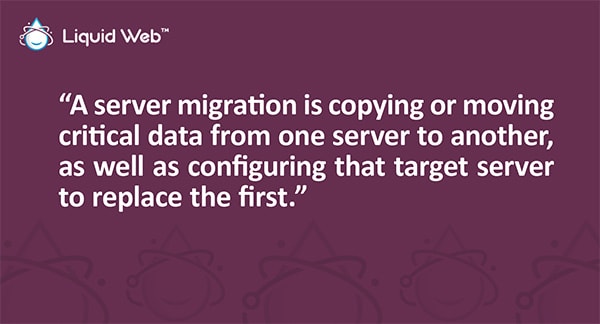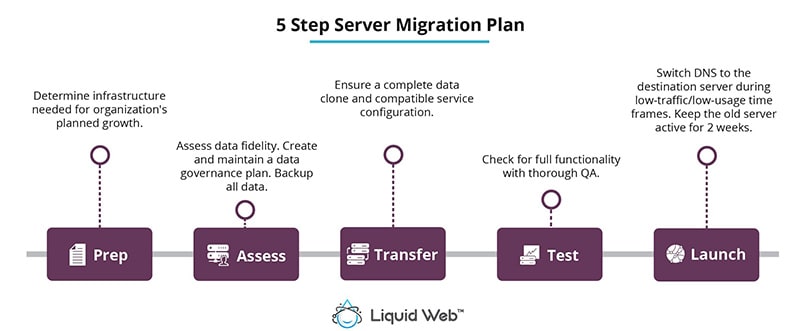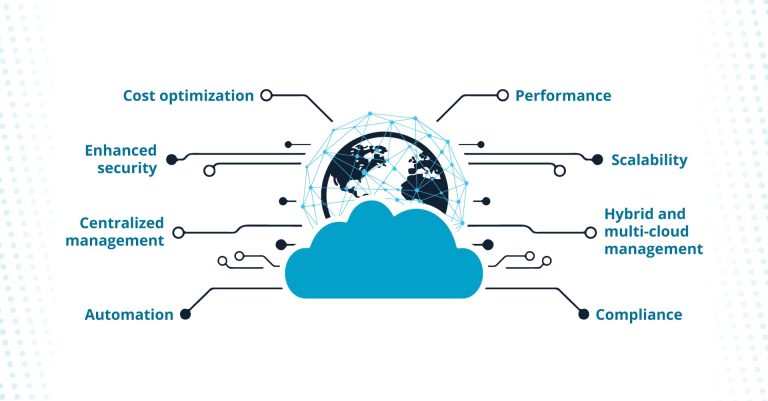Discover the essential steps you need to take to ensure your next server migration is a success!
As your websites and applications grow, you’ll reach an inevitable crossroads where you’ll need to undertake a server migration. The following step-by-step guide will prepare your team for the entire process – from migration day and beyond.

What is a Server Migration?
Server migration describes copying or moving critical data from one server to another, as well as configuring that target server to replace the first. In the context of web hosting, server migrations might revolve around setting up web servers and database software, copying websites and their configurations, or changing DNS parameters to direct visitors to the new target server.
What Does Migrating Hosts Mean?
When IT professionals discuss migrating hosts, they’re referring to the action of migrating data from one server to another. The process typically involves one or two servers, depending upon the host server’s configuration.
If a host server is partitioned into several virtual servers or containers, the source and destination hosts will exist within the same machine. This means they will only require one server. On the other hand, if data is being migrated to a destination host on an entirely different physical machine, the host migration would take place across two separate servers.
How Long Does a Server Migration Take?
A typical server migration can take anywhere from 30 minutes to 3 hours. This is because the time spent migrating servers will depend heavily on the size of the data transfer. Servers only have a certain amount of bandwidth to accommodate tasks like these. Migrating a larger number of files and applications will require more of the server’s bandwidth – ultimately taking longer to complete.
Types of Server Migrations
Hosting experts assessing how to migrate data from one server to another have various techniques to rely on. Your current hosting framework may require one of the following methods, depending on the system’s configuration:
Physical-to-Physical (P2P) Migration
Physical-to-physical (P2P) migration contains no virtual resources. This method only applies to migrating from one physical server setup to another. Hosting experts rely on software tools to remove server drivers from the original host machine and install them on the new target machine.
Physical-to-Virtual (P2V) Migration
In this method, IT staff migrates data from a physical server to a virtual location. The operating system, all files, and data transfer to a virtual machine. The new target server typically exists on a virtualized platform, and the transfer may require decoupling before the migration can begin.
Virtual-to-Virtual (V2V) Migration
With virtual-to-virtual (V2V), the server migrator transfers files from one virtual location to another. Most virtual platforms contain native tools to help with this type of migration.
IT admins should consider staying within the same platform and using tools to make the migration as hassle-free as possible. If it’s absolutely necessary to migrate to a different platform, you may want to enlist the help of third-party migration tools. The native tools from your original platform won’t provide much support.
Cloud Migration
As the name suggests, cloud migration involves moving an organization’s server resources to the cloud. This can be a complete or partial transfer, depending on the company’s needs. Additionally, cloud migration covers data moves from a physical to a cloud server or between two cloud servers.
Operating System (OS) Migration
Operating system (OS) migration involves switching your server from one operating system to another. IT admins perform this type of migration when updating their current operating system to a new version. They may also use an operating system migration if it’s necessary to shift to an entirely new operating system, like switching from Linux to Windows.
Database Migration
Database migration requires moving data from a source database to a new target database. IT staff may use a database migration service to perform this task to ensure it’s done safely and properly. After the migration, all stakeholders needing access shift to the new database, and the old source database is shut down.
Application Migration
App migration involves relocating an organization’s software from one server to another. This type of server migration can involve a shift from a legacy server to a cloud or virtualized environment or from one virtual environment to another. Traditionally, organizations use this method as part of a larger strategy to upgrade their technology from legacy formats to current business standards.
Why Should I Consider a Server Migration?
Several possible scenarios might make a server migration necessary. Organizations may migrate to
- take advantage of new technology or better services or ensure that the operating system (OS) and the hardware the new technology relies on stay up to date. Occasionally, you may need to double-check your OS to ensure you avoid running a version that’s rapidly approaching its end-of-life (EOL). An example would be Linux CentOS 7, which will go EOL in June 2024.
- move to the cloud for increased flexibility or scalability.
- economize and consolidate hosting – reducing CapEx.
- replace aging infrastructure at the end of its lifecycle.
- expand and distribute hosting to help reduce load at a single point and achieve high server availability.
Migrating servers can be a tricky process and should be handled with the utmost care. You could sink hours of time, effort, and money into a migration only to find yourself on the wrong server solution, resulting in significant downtime and profit loss.
It takes considerable planning and forethought to migrate data from one server to another without major hiccups. After all, downtime can cost enterprise-level businesses about $1,000,000 per hour, so a successful server migration is crucial to the health of your organization.
How Do I Plan for a Server Migration?
Even though server migrations are quite common, the most experienced IT professionals get nervous when it’s time to initiate the steps. With so many moving parts, it is very easy – and very common – for migrations to cause at least a little anxiety.
Alleviate some of that tension by planning ahead for the migration. Instructing your team to start thinking about data migrations early is critical for ensuring smooth, fast migrations that deliver the intended benefits without causing headaches along the way.
While a server migration checklist is helpful, moving to a new environment can still be a complex procedure. Even deciding what belongs on the list requires careful consideration. A clean data migration plan requires extensive system exploration and preparation by the company’s IT personnel, but surprises are possible even after the most diligent preparation. IT teams must carefully plan the tasks that take a lot of time or consume a large amount of system bandwidth.
Organizations that do not leave a long enough lead time for their migration project often find that they experience business disruptions or unexpected costs, even if they do everything else right.”
A complete and accurate picture of your existing infrastructure – including all data, hardware, software, and network components – is necessary for successful data migration. Before the migration even begins, your IT staff should conduct a complete documentation of your infrastructure. This will serve as your blueprint to properly construct your new environment and avoid missing any crucial details or files during the migration.
This roadmap of your organization’s IT infrastructure also informs the rest of the planning process. Performing a thorough discovery can also have the added benefit of uncovering potential problems like forgotten web applications running an unsupported scripting language or broken URLs. Preparation takes many forms beyond the initial exploration phase, including scheduling, communicating with staff, and technical measures like updating the LAMP stack, if necessary, along with code and plugins.

5-Step Server Migration Plan
As we mentioned, a complete and successful server migration consists of several steps. Those numerous, necessary steps when migrating servers tend to fall into one of five primary categories that make up the overarching migration process.
Understanding how these broader steps fit together and what is included in each is critical to developing your exact strategy.
1. Preparing Your New Server
In the simplest terms, think of a server migration as moving from one home to another. If you want to bring all your possessions, your new home needs enough space, right? And if you are used to having a double vanity in your bathroom, for example, you may want the same features in your new home.
Migrating servers is very similar. All the data associated with your website and applications need to fit properly on your new server. Consequently, ensuring that your new server is appropriately sized and configured for any incoming data and digital assets is important. It’s also essential to make sure that mission-critical services and packages your sites depend on are installed and available in the new environment.
Key Questions To Consider During Server Preparation
- What is your organization’s planned growth over the next five years, and what infrastructure changes will this require?
- Are all the right parties involved or informed of the planned migration? Think about site editors, administrators, developers, visitors or end-users, and your hosting provider(s).
TIP: Build in approximately 20% extra storage space when migrating. During the migration, you’ll need a little extra room to unpack and install the data that’s being migrated, and you will want some room to accommodate future growth as well.
2. Assess Data Fidelity
The process of making sure all data is accounted for before the migration (and properly installed after) is of critical importance. Losing even a tiny fraction of your data in transition, such as one CSS file or connection string, can impact the performance of your entire site or application.
We recommend spending some time before the migration noting what parts of your site are critical and what parts interact with or engage with other services. For example, plugins and themes that affect multiple pages should be checked both before and after migration to ensure identical functionality.
Key Questions To Consider When Assessing Data Fidelity
- What is the quality of the data in your old server? Are there a lot of static files or dynamic databases?
- Do you have a data governance plan in place to ensure measurement, tracking, and better decision-making during the migration process?
3. Data Transfer
Data transfer is typically the most time-consuming part of the migration. Once you’ve prepared your new server and properly secured all data, you’re finally ready to start the transfer.
The bandwidth available between your old server and the new server (or between your old hosting provider and your new hosting provider) serves as the conduit for the migration. The more bandwidth you have, the faster the data can be migrated, and the less downtime you’ll need.
Key Questions To Consider During Data Transfer
- Are all parties on the same page regarding when the data transfer will occur?
- Is there a clear POC between your old and new hosting providers?
- Are there any major initiatives or high-traffic events planned during or around the migration timelines?
TIP: Let anyone with access to the site know when the migration is going to happen and how long it is expected to take. Putting a “freeze” on any websites or applications will better ensure that no new content or data is lost during the migration.
4. Testing (QA/QC)
Once you’ve actually migrated the data from one server to another, it’s time for testing. Checking for full functionality and complete data transfer may be time-consuming and cumbersome, but that is time well spent to prevent discovering an issue at a much later date.
Since testing is usually one of the migration steps where surprises are most likely to happen, the time spent during this phase can vary significantly. Organizations often find that leaving adequate time to complete the testing process is much easier if planned well in advance.
Conducting rigorous testing is how organizations identify unanticipated issues, evaluate the effectiveness of their issue resolution strategies, and confirm the details of how running internal systems in the new environment will look.
Finally, documenting how you will perform post-migration testing is as important as any other step on the server migration checklist. Accurate testing and analysis ensure quality assurance and quality control and guarantee process improvement from one migration to the next.
Key Questions To Consider During Testing
- Have you verified appropriate request responses for APIs between applications and servers?
- In multi-server setups, are public and private traffic moving along the appropriate networks?
- Are your site(s) or application(s) performing as expected?
TIP: Reference your previous site and server during the testing process to see if anything looks off or incomplete. So long as the prior server was functional, it can provide a good roadmap for what your website should look like in its early life on the new server. Sometimes, server migrations present excellent opportunities for uncovering existing site issues!
5. Changing DNS and Going Live
Now that you’ve migrated all your data, applications, and websites to your new server and performed sufficient testing, it’s time to switch your DNS. This switch is essential as it directs traffic from the old server to the new infrastructure.
Pointing your server at a new DNS is a relatively simple process. The steps are straightforward, but doing them incorrectly may affect your site’s performance. We advise that you make your DNS switch during off-peak usage hours. The middle of the night, weekends, or holidays typically work best.
Key Questions To Consider When Switching DNS
- Have you double-checked that there are no business-critical events in the next 72 hours following going live?
- Are all parties clear on their duties for going live?
- Do you have a backup, reversion, or correction plan in case something goes wrong?
Keep the Old Server Active as Short-Term Protection
Are you wondering what to do with your previous server now that it’s not in use? Our recommendation is to leave the old server active for at least a week or two as a point of reference and fallback option in the event an unknown problem rears its head. Leaving your old server running for a transition period offers excellent protection against unforeseen issues.
What Should You Avoid During Server Migrations?
Avoid the following during server migrations:
- Avoid scheduling a move immediately before a critical period for your business (such as Black Friday for an online retailer) to prevent a problem that needs to be fixed in an unrealistic time frame – turning it into a major disruption.
- Migrations should generally be performed during off-hours or when minimal business is expected. This reduces the chances of disruption, allows the IT team to focus solely on the migration, and prevents the legacy environment from being overwhelmed or the network from becoming saturated.
- Avoid starting a migration until the exploration period is complete. An incomplete exploration is one of the main sources of preventable problems in migration projects of all kinds. It can be a lengthy process, but the time invested upfront will save you and your team countless headaches in the long run.
- Notify staff outside of the migration team about the migration. This includes migration timelines, the changes expected to occur, and responsibilities, if any, that may be included as part of the project. You may need to distribute documentation to inform your staff or have a window of time in which IT personnel can assist end users with the initial set-up process.
How Can a Service Provider Help With Server Migrations?
Most service providers can address a significant pain point for their potential customers by offering to help with migrations. However, not all hosts have the combination of customer migration skills and motivation to follow through in a way that makes the experience as smooth as possible.
The requirements for migrations are significantly different depending on what is being migrated and the environments involved. Things can get quite complicated depending on the size of your organization and infrastructure.
As we previously wrote about migrating data between cPanel servers, service compatibility is the real magic of migrations. The magic spells, in this case, are the configurations and combinations of versions which will work together.”
In the discovery and documentation portion of the process, your web host’s migration veterans can work with your internal IT administrators to ensure that all relevant information is identified from the beginning. Now your provider knows exactly what to look for. Your hosting provider can also help estimate how long some steps will take, including the final move.
Important details about how a particular environment runs, such as ensuring the establishment of quorum in a server cluster, may be obvious to migration experts but not so clear to in-house IT staff during a major operation. After helping organizations through many migrations, service providers can anticipate some of the questions IT teams are likely to be asked by non-IT staff. A service provider’s experience from migrating countless customers is just a fraction of the benefits organizations can experience by partnering with an expert.
Crafting a new environment to suit your business’s needs is challenging. Even after a thorough discovery, guidance from professionals with in-depth knowledge of all the components of the prospective new environment can be invaluable. Likewise, the experience of experts familiar with storage and networking, your operating system, and the procedures involved in both sides of the migration can all be valuable throughout the data migration process.
From exploration and creating a project plan through testing and execution, organizations can avoid numerous, potentially expensive pitfalls with the right help.
A Better Understanding of Server Migration Steps
Server migrations are simple to understand but often complex to execute. The overarching concepts that make up a successful migration mean anyone can do them. While often numerous, the details of each step on the server migration checklist are not necessarily complex. One of the best things you can do to ensure a successful and complete migration is to engage experts who know the path and can guide you on the journey.
Here at Liquid Web, our Most Helpful Humans in Hosting™ perform thousands of migrations every year and understand what roadblocks and pitfalls to avoid. If you are considering migrating to a new server, get in touch now.
We would be happy to discuss what goes into a successful dedicated server migration and help architect the right infrastructure for your needs. Migrating to a new server is a big decision and a process best undertaken with a trusted partner by your side.
Server Migration FAQs
How does server migration work?
+
What is the difference between application migration and server migration?
+
Why do I need to migrate servers?
+
Do I need to test after server migration?
+
What are the risks associated with server migration?
+




